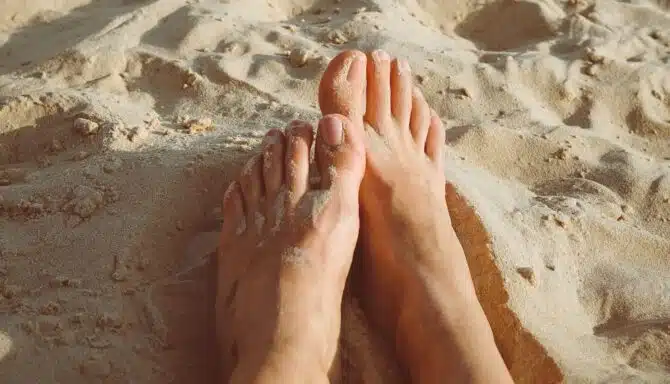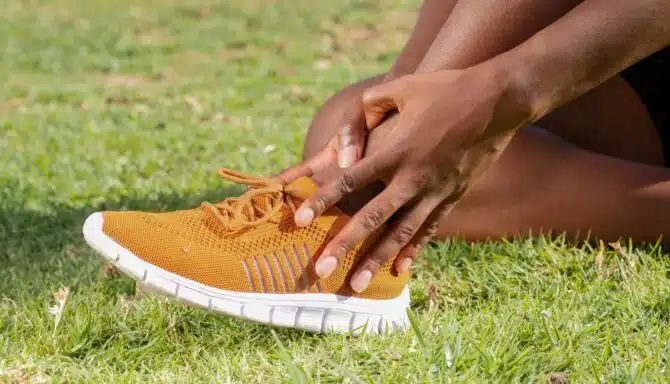April 18, 2024
Innovation has always been important in the healthcare world, with chiropody and innovative foot treatments being no exception! These days, with advanced foot care, you can enjoy pain management and comfort without resorting to a time-consuming ordeal like surgery. Let’s explore the services you can participate in thanks to innovation and great ideas!
Innovative Treatments for Common Foot Problems in 2024
Confusing and lengthy procedures can cause you to neglect the foot condition you may be struggling with, so modern treatments should save you time and put you at ease! Here are some of the best innovative treatments available today:
Shockwave therapy
Custom orthotics
Video gait analysis
Onyfix
Splinting and taping
Shockwave Therapy
Healthcare professionals have been using shockwave therapy to address musculoskeletal conditions since the 1980s. While the term “shockwave” can be off-putting, it’s a totally non-invasive procedure and most patients report very mild discomfort and no pain.
Shockwave therapy is quickly shaping up to be one of the best Achille’s tendonitis, Morton’s neuroma, and plantar fasciitis solutions. It works by targeting injured tissues, boosting blood circulation and stimulating a natural healing response in our bodies.
To learn more about shockwave therapy, click here.
Custom Orthotics
Orthotics date back to ancient civilization when humans started to realize their feet needed more support! As the centuries passed, they have become one of the most innovative treatments because now chiropodists and manufacturers can mold them to fit your specific needs. Custom orthotics treat a wide range of conditions and help correct your gait.
To learn more, click here.
Video Gait Analysis
A video gait analysis uses technology and visuals to determine what type of unique gait (walking pattern) you have. Think of it as a much more advanced version of walking on a treadmill! It gives your chiropodist the insight they need to help you correct it and avoid pain as much as possible.
To learn more, click here.
OnyFix
Imagine if you could alter your nail growth pattern without using invasive tools? Primarily used as an ingrown toenail treatment, OnyFix uses composite material to ensure your nails grow evenly and correctly! It’s one of the newest chiropody treatments and only became popular in North America within the past decade or so.
To learn more, click here.
Splinting, Taping and Correction
Tapes, splints and other devices can help people manage foot deformities without surgeries. For example, patients often experience bunion relief with bunion correctors, which are both affordable and comfortable and put your toes in an optimal position. Splinting and taping can also do the same for various conditions!
To learn more, click here.
December 18, 2023
Compared to other purchases, shoes warrant a lot of thought and consideration. Wearing improper footwear is directly linked to foot pain and can turn into debilitating foot conditions. These conditions range from musculoskeletal pain (pain in the joints, muscles, ligaments and bones) to debilitating skin and nail issues. In other words, forcing your feet to operate in an inhospitable environment is a recipe for disaster!
Let’s take a look at how your bad shoes are causing you discomfort, and learn about some of the best solutions for foot pain and footwear-related health tips.
Image Credit: iStock
Why Does Improper Footwear Cause Foot Pain?
Research suggests that between 63 and 72% of people with foot pain wear shoes that are too small, too narrow and too cramped in the toe box. They also often lack the right amount of arch support, cushioning and protection from the ground’s impact. Studies also show that wearing poor shoes for decades can be a major reason why seniors experience foot pain today!
In a nutshell, inadequate footwear can ultimately disrupt the biomechanics of the feet, resulting in persistent pain and potential long-term damage.
Image Credit: iStock
Foot Conditions and Wearing Improper Footwear
From severe toenail pain, to dull aches, to nagging skin irritation, bad shoes can cause pain in more ways than one. Here are just a few issues you may be struggling with today:
Bunions and Hammertoes: Caused by narrow toe boxes and high heels.
Plantar fasciitis: Caused or contributed to by a lack of arch support.
Ingrown toenails: Can occur due to tight and narrow shoes that disrupt normal nail growth patterns.
Blisters: Due to a lack of cushioning and excessive rubbing against the skin.
Achilles Tendonitis: Contributed to by inadequate heel and arch support.
Diabetic foot: Ill-fitting shoes can lead to an increase in vulnerable pressure points, reduced blood circulation, and heightened risk of foot ulcers.
Please note that some conditions may be so advanced that they require medical shoes or orthopaedic shoes.
Image Credit: iStock
Revamping Footwear and Foot Health Tips
There are a few different ways to find comfortable footwear. First, you can try a shoe fitting service at Feet First Clinic. A staff member will guide you through available options and answer any questions you may have (staff members at regular shoe stores are often unable to answer these questions properly!).
Or, you can book a full footwear assessment and video gait analysis with a chiropodist. This gives you more insight into how you carry your weight and what parts of your feet need the most support.
If you choose to venture out on your own entirely, check out this checklist before you go shopping!
Lastly, you can double up on protection by investing in custom orthotics and wearing them with shoes that come with removable insoles.
Image Credit: iStock
November 6, 2023
Have you ever experienced that uncomfortable sensation of numbness in your toes? It's a temporary disconnect between your brain and lower extremities and may leave you wondering, "What's going on?"
Numb toes range from a minor problem to a potentially severe issue, and understanding the reasons behind this unique sensation is the first step toward finding relief.
So, if you've ever wondered why your toes sometimes go on strike, keep reading to learn more about the leading causes of numb toes and when to seek medical attention.
Numb toes: The most common causes
There are several causes of numb toes. Below, you'll find some of the top contributors and their signs.
Poor Circulation
Reduced blood flow to the toes can lead to numbness. This can occur due to sitting or standing in one position for too long, wearing tight shoes, or sitting with your legs crossed. In these cases, the numbness is usually temporary and goes away once you change your position or remove any constricting clothing or footwear.
Peripheral Neuropathy
Peripheral neuropathy involves damage to the peripheral nerves, often due to diabetes, alcohol abuse, vitamin deficiencies, or other underlying medical conditions. Symptoms can include numbness, tingling, and pain in the toes and feet.
Nerve Compression
Conditions like sciatica or a herniated disc in the lower back can compress the nerves that supply sensation to the legs and feet, causing numbness and tingling in the toes.
Frostbite or Frostnip
Frostbite is an injury caused by freezing the skin and underlying tissues. Your skin becomes cold and red, then numb, followed by hardening and paleness. Depending on the severity, you may experience frostnip (the early onset of frostbite or superficial frost bite) or deep frostbite, which involves more severe stages of nerve damage.
Tarsal Tunnel Syndrome
Like carpal tunnel syndrome in the wrist, tarsal tunnel syndrome involves compression of the tibial nerve in the ankle, leading to numbness and tingling in the toes. The tarsal tunnel is a narrow space inside the ankle next to the ankle bones, through which the tibial nerve runs. A thick ligament covers the tunnel and helps contain its inner workings – veins, arteries, tendons, and nerves. Tarsal tunnel syndrome is the most common kind of nerve compression in the ankle. Underlying causes of tarsal tunnel syndrome include direct trauma to the tarsal tunnel, flat feet, fallen arches, growths in the tarsal tunnel, and varicose veins.
Morton's Neuroma
Another type of nerve compression, Morton’s neuroma, may lead to numbness in your toes. The most common site is at the ball of the foot between the third and fourth toes. As this nerve is thicker than its surroundings, it’s at a greater risk of being blocked, which can cause numbness in the toes. You may feel a numbing sensation or like you have a pebble in your shoe.
Raynaud's Disease
Raynaud's causes blood vessels in the fingers and toes to constrict excessively in response to cold temperatures or stress. This can lead to numbness and discoloration of the affected digits.
Injuries
Trauma to the foot or toes, such as fractures or compression injuries, can cause temporary numbness. For instance, ankle or Achilles heel injuries can directly or indirectly impact the tarsal tunnel region.
Infections or Abcesses
Toe or foot infections can lead to numbness, mainly if they spread to the nerves.
Circulatory Disorders
Conditions like atherosclerosis or blood clot formation can reduce blood flow to the toes, causing numbness.
Tight Footwear
Shoes that are too narrow in width or too small in length can compress your toes and reduce blood circulation. Ensure you are correctly fitted with the right pair of footwear to allow enough space for your toes to move. You can even do a shoe sizing and fitting session here at Feet First Clinic, choosing from leading footwear.
When should you seek medical help for numb toes?
We recommend that you seek help for numb toes if any of the following apply:
The numbness in your toes is persistent, recurring, or unexplained.
You have diabetes - Numbness in the feet can be a sign of diabetic neuropathy, which requires proper management.
You experience numbness, weakness, coordination loss, or other neurological symptoms.
There is a sudden onset of numbness, especially after an injury or in combination with other concerning symptoms.
It's crucial to remember that numbness in the toes can be a symptom of various underlying conditions. An accurate diagnosis from a healthcare provider can be helpful when treating and ruling out any serious underlying issues.
July 10, 2023
Not all foot conditions are associated with pain. Sometimes, the concern stems from the opposite - a lack of feeling. Partially losing sensation or experiencing a tingling feeling in your toes is common. What's occurring is numbness in your toes.
Numbness in the toes can be caused by various factors, ranging from temporary issues to more serious underlying conditions. Here are some common causes, prevention tips, and guidelines for seeking medical attention.
Causes of numbness in toes
Several foot and toe conditions may cause numbness in your toes. The condition may be acute or chronic, depending on the onset and severity of pain.
Peripheral neuropathy
Diabetes, vitamin deficiencies, or nerve compression often cause damage or dysfunction of the peripheral nerves (nerves outside of the brain). When the peripheral nervous system doesn't work as intended, you can experience numbness in your hands, feet, and toes. The main symptoms include a burning or sharp sensation or a gradual onset of numbness or prickling. You may also experience pain in random non-painful scenarios, like using a blanket, putting on socks, or standing up.
Nerve compression
Nerve compressions in the foot, like tarsal tunnel syndrome or Morton's neuroma, can cause numbness in the toes.
Tarsal tunnel syndrome occurs when the tarsal tunnel is compressed. Imagine squeezing a casing of wires: The more pressure against the case, the more stress is put onto the fillings inside. In this case, those would be the nerves, arteries, and tendons inside. Tarsal tunnel syndrome (TTS) is caused by posterior tibial nerve compression as it travels through the tarsal tunnel.
Meanwhile, Morton's neuroma is a nerve compression that targets the area at the base of the toes. The most common site is at the ball of the foot between the third and fourth toes. As this nerve is thicker than its surroundings, it's at a greater risk of being blocked, which can cause numbness in the toes. You may feel a numbing sensation or like you have a pebble in your shoe.
Poor circulation
You may experience numbness in your toes due to reduced foot blood flow. For instance, peripheral artery disease (PAD) occurs when blood vessels narrow or are blocked, generally by the buildup of fatty plaque in the arteries.
Raynaud's
Those who have Raynaud's may experience numbness in their toes, especially in cold temperatures or times of stress. In Raynaud's disease, blood-supplying arteries narrow, which reduces blood flow to the area. The most common visible symptom of Raynaud's is your skin turning pale or blueish.
Frostbite
Frostbite is an injury caused by freezing the skin and underlying tissues. Your skin becomes cold and red, then numb, followed by hardening and paleness. Depending on the severity, you may experience frostnip (the early onset of frostbite, or superficial) or deep frostbite, which involves more severe stages of nerve damage.
Herniated disc
A herniated disk is a nerve impingement in the lower back. When the nerve is pinched, it can radiate numbness down the leg and into the toes. Disk herniation is often the result of ageing and wear and tear over time.
Injury or trauma
Acute injuries, like foot or toe injuries, can cause nerve damage and numbness. Acute injuries may include broken bones, sprains, or fractures.
Prevention for numbness in toes
Preventing numbness in your toes involves a holistic approach to healthy habits, investing in your feet, and practicing good posture. Here's what we recommend for preventing numbness in your toes:
Adopt a healthy lifestyle: Proper nutrition, regular exercise, and managing conditions like diabetes can help prevent peripheral neuropathy and circulation problems.
Supportive shoes: Invest in high-quality footwear made for your foot and its use. Wear specific shoes for the activity if you're playing sports, or work shoes, depending on your profession. Shoes should provide adequate arch support, protection, as well as cushioning.
Avoid prolonged pressure on your legs and feet: Avoid sitting or standing in the same position for excessive periods, as it can lead to nerve compression and reduced blood flow.
Practice good posture: Proper posture and ergonomics can help prevent nerve compression in the lower back. Consider investing in a standing desk or a good chair or revamping your at-home office if you need to improve your posture.
When to see a specialist for numbness in toes
Proactively seeing a doctor when you experience numbness in your toes is recommended. It's challenging to replicate getting a proper diagnosis, determining the cause, and building a treatment plan at home like you would with a doctor or foot specialist.
However, not all conditions or pain require seeing a specialist. So, how do you know when to see a doctor or foot specialist? Below are a few scenarios for numbness in the toes in which we recommend booking an appointment:
Chronic or persistent numbness: If numbness in the toes persists for an extended period, despite self-care measures, you should seek medical attention.
Progressive symptoms: If the numbness worsens over time or spreads to other areas, it's essential to consult a healthcare professional.
Pain or difficulty walking: If numbness is accompanied by severe pain or difficulty walking, there may be a more serious underlying condition requiring evaluation by a specialist.
Traumatic injury: If numbness follows a foot or toe injury, seeking medical attention to rule out nerve damage or fractures is advisable.
Associated symptoms: If numbness is accompanied by symptoms elsewhere or the symptoms begin to differ, for instance, muscle weakness, loss of coordination, or other neurological symptoms, it should be evaluated promptly.
If you are experiencing any of the above symptoms, you should first visit your family doctor. Your family doctor can order the testing required to properly diagnose (or rule out) potential causes of your toe numbness.
April 3, 2023
Are your feet giving you a hard time? Foot pain can have many causes, including injury, overuse, medical conditions, and poor footwear. The underlying cause will dictate how to treat your foot pain, which can include anything from supportive footwear, to stretching exercises, to rest, to medication.
In this article, we'll go through six common causes of foot pain and how to treat them:
Plantar Fasciitis
Achilles Tendonitis
Bunions
Ingrown Toenails
Osteoarthritis
Plantar fasciitis
Causes
Plantar fasciitis occurs when the plantar fascia (the band of tissue that connects the heel bone to the toes) becomes inflamed. It is caused by inadequate arch support or overexerting the plantar fascia. For instance, poorly constructed shoes, obesity and pregnancy, high-impact activity, and long periods of standing (like if you have a standing desk or work in a standing-first occupation) cause strain on the plantar fascia.
Treatment
Plantar fasciitis treatment involves rest and recovery, which should be the first course of action. Then physical therapy, like massaging your arch and stretching and strengthening exercises, are effective. Additional treatment methods include shockwave therapy, taping, wearing a splint or boot cast, and custom orthotics designed to provide additional arch support.
Read more: See our complete guide on plantar fasciitis.
Achilles tendonitis
Causes
Achilles tendonitis is an injury to the Achilles tendon, the part of the leg that connects the calf to the heel bone. It is usually caused by overuse. Overworking the Achilles heel is done through various avenues. The most common causes include overexercising, weight gain, joint disorders like rheumatoid or psoriatic arthritis, bursitis, a sudden fall or past trauma, and biomechanical abnormalities.
Treatment
Within 72 hours of injury, the first form of treatment you should pursue is rest and recovery. Good R&R prevents aggravation and stops the condition from worsening at its most vulnerable. Once you remove the cause, effective treatment methods include shockwave therapy, strengthening and stretching exercises (see our how-to), custom orthotics, and anti-inflammatories.
Read more: See our complete guide on Achilles tendonitis.
Bunions
Causes
Bunions are a type of joint deformity where the base of the big toe shifts outwards. There is a combination of factors that can either cause, directly or indirectly, bunions. Genetics (namely foot shape or joint-related), tight footwear or high heels, flat arches, and activities that stress the toe base (like running or ballet) can lead to bunions.
Treatment
Treatment options include footwear modification, anti-inflammatories, bunion splints, bunion aligners, taping, shoe stretching, orthotics, shockwave therapy, and surgery. Note that bunions are progressive, meaning non-invasive treatment focuses on preservation rather than reversing damage already done. Surgery is an option if you'd like to remove the bunion.
Read more: See our complete guide on bunions.
Ingrown toenails
Causes
Ingrown toenails occur when the edges of the toenail grow into the skin, causing pain and swelling. Ingrown toenails can be caused by:
Cutting the nail too short or too far down along the edges
Poorly fitted shoes.
Injury to the nail bed.
A genetic disposition to ingrown toenails.
Treatment
In some cases, you can treat ingrown toenails at home; otherwise a foot specialist can treat the condition. To treat your ingrown toenail at home, soak your foot daily in warm water with Epson salts, massage the skin at the edges of the nail, wear shoes with a wide toe box, and let the toenail grow out. When it does, cut the nail straight across. Never try to cut out your own ingrown toenail as this can lead to infection.
If the toenail doesn't improve within 3–5 days, it's time to call the foot specialist. A foot specialist can safely treat ingrown toenails at any stage. In-office ingrown toenail treatment includes antibiotics, softening the skin around the nail, removing or cutting open the area to drain pus, Onyfix nail correction system, partial or complete nail avulsion, phenol, or surgery.
Read more: See our complete guide on ingrown toenails.
Osteoarthritis
Causes
Osteoarthritis is the most common form of arthritis and is caused by wear-and-tear of the cartilage between the joints. Getting old is the most common cause of osteoarthritis. Our joints get more mileage as we age and eventually wear down. Low bone density (for instance, in post-menopausal women) can also lead to osteoporosis, contributing to osteoarthritis (it would be like having defective brake pads). Additionally, unhealed trauma or injury, weakened deconditioned muscles, sudden weight gain, and biomechanical abnormalities like hammer toes or bunions can all lead to osteoarthritis.
Treatment
Treatment of osteoarthritis focuses on management, as it's a progressive condition. Physiotherapy, stretching, and light exercise to strengthen the muscles in the lower body is vital for managing osteoarthritis symptoms and preventing the condition from worsening. This can be done in conjunction with proper footwear and medication like anti-inflammatories. Custom orthotics can also help by effectively rebalance the weight distribution across your feet while adding support.
Read more: See our complete guide on osteoarthritis.
March 2, 2023
Many different foot issues fall under the "foot injuries" umbrella.
From sprains and broken bones that leave you bedridden to overuse injuries that make your days more painful, it would take a full day to discuss every foot injury in detail!
That's why we're aiming to give this article a positive spin by switching the focus to treatment and how a chiropodist can help you. But first, it's important to discern between the two types of injuries and how the type you have will determine your approach to treatment.
Today's blog will discuss the following:
What are some common foot injuries?
Examples of overuse injuries
Examples of acute injuries
How do chiropodists treat and prevent foot injuries?
What Are Some Common Foot Injuries?
When discussing foot injury treatment, it's important to distinguish the cause of the injury and whether or not sudden, acute pain is present.
Some injuries cause everyday pain flair-ups that can be a real nuisance but aren't enough to make you feel like you must go to the hospital. These are "overuse" injuries because they stem from straining your muscles and joints and withstanding repetitive, mild trauma.
These injuries arise when we exert intense physical activity too quickly without proper stretching, exercising and footwear. However, you don't have to be an athlete to succumb to an overuse injury; you can also develop one due to wearing ill-fitting, unsupportive shoes while working on your feet all day.
On the other hand, some injuries are sudden and result from a fall or misstep. They can also result from the blunt impact of an object falling on your foot. These are often more debilitating in the days that follow the injury.
Examples of Overuse / "Everyday" Foot Injuries
Achilles Tendonitis: Occurs due to Achilles tendon inflammation (connects your heel and calf along the back of the foot).
Plantar Fasciitis: Inflammation of the thick band of tissue that runs along the bottom of the foot (plantar fascia). Often caused by overuse, poor footwear choices and repeated walking on hard surfaces.
Morton's Neuroma: Results from the irritation and thickening of the tissues surrounding the nerves that lead to your toes. Patients notice pain in the ball of the foot.
Shin splints: Pain along the shin bone caused by overworking muscles, tendons and bone tissues, commonly found in athletes and dancers.
Heel spurs: A calcium deposit that causes a bony protrusion underneath the heel bone. They may be painless or cause sporadic heel pain.
Capsulitis (big toe or second toe): Joint inflammation in the area where the toe's base meets the foot's ball.
Stress Fractures: Tiny cracks in the weight-bearing bones of the lower leg and foot due to overuse and playing sports with excessive jumping and running.
Examples of Sudden (Acute) Foot Injuries
Ankle sprains
Broken bones in the foot due to blunt force trauma
Bruises(contusions)
Puncture wounds
Ruptured tendons
How Do Chiropodists Treat and Prevent Foot Injuries?
Overuse / Everyday Injuries Treatment and Prevention
Chiropodists are known for successfully treating and preventing overuse injuries. They pride themselves on giving patients the tools to manage pain and improve their quality of life. Some of the most effective services include:
Custom orthotic fittings
Recommending exercises and stretches
Shockwave therapy
Footwear modification guidance
Periodic foot assessments
Custom Orthotic Fittings
These inserts fit into virtually all of your footwear, help stabilize your feet and ankles, and take the stress off the weight-bearing areas of the feet. They are one of the most multi-purposeful medical devices for foot injury recovery and can aid almost every foot condition. The goal is to use your foot as the blueprint to create the perfect pair of orthotics that keep your foot in the ideal position for healing and pain management.
Recommending Exercises and Stretches for Target Muscles, Tendons, Ligaments and Joints
Feet First Clinic's Pinterest Board has several options for stretches that help with plantar fasciitis, Achilles tendonitis, ankle strengthening, and much more. These routines are also tools you can use to strengthen your foot, protecting you from a future overuse or sudden injury. These stretches and exercises also fit nicely into your foot care regimen!
Shockwave Therapy
This modern and non-invasive therapy treats soft tissue injuries like Achilles tendonitis, plantar fasciitis, Morton's neuroma and muscle strain. After thorough preparation, a chiropodist uses an applicator to deliver energy pulses to the affected areas. It is a quick, pain-free treatment lasting only 5-20 minutes.
Footwear Modification Guidance
Chiropodists have a keen sense of what shoes to recommend depending on individual needs. A shoe fitting at a foot clinic keeps you from developing an overuse injury and can help in the rehabilitation phase of a more severe injury.
Periodic Foot Assessments
A foot assessment is like a full body physical that focuses solely on your feet. Likewise, you will need updates on how your overuse or acute injury is recovering and if your progress is continuing along nicely. For those without glaring foot issues, a foot assessment is recommended once per year. If you have a healing injury, you should see your chiropodist for an assessment every six months or less, depending on your situation.
Sudden Foot Injuries Treatment and Prevention
Now let's get into the more debilitating foot injuries.
First and foremost, you shouldn't immediately see your chiropodist after experiencing a blunt form trauma injury, sudden ankle sprain or any other type of acutely painful accident. On the day you sustain such an injury (and the immediate days that follow), you may have to get MRIs or X-ray images in addition to crutches or a physical exam from a physician. You should then practice the R.I.C.E (rest, ice, compression, elevation) method from home while you take it easy and avoid walking.
However, chiropodists can help immensely with injury recovery after the acute pain phase passes. Chiropody treatment for ankle injuries like sprains or broken bones in the foot typically occurs during rehabilitation or when the patient has begun healing and needs to regain control of their motion via therapeutic intervention.
To learn what treatment methods are available, you can simply revert to our list for overuse injuries. You can also use the preventative measures we've already mentioned, but we have a few additional tips worth noting:
Reduce your chances of ankle sprains by focusing on stretches that improve ankle flexibility and strength.
Watch your step when walking and playing sports to avoid breaking a bone or sustaining a sprain.
Wear shoes that offer extra ankle support to avoid sprains.
To prevent accidents at home, wear shoes or orthopaedic slippers indoors and take your time walking while tired or impaired for any reason.





